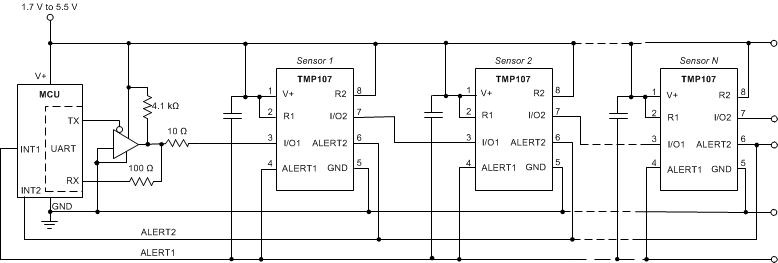JAJSIC9A October 2015 – October 2015 TMP107-Q1
PRODUCTION DATA.
- 1 特長
- 2 アプリケーション
- 3 概要
- 4 改訂履歴
- 5 概要(続き)
- 6 Pin Configuration and Functions
- 7 Specifications
-
8 Detailed Description
- 8.1 Overview
- 8.2 Functional Block Diagram
- 8.3 Feature Description
- 8.4 Device Functional Modes
- 8.5 Programming
- 8.6
Register Map
- 8.6.1 Temperature Register (address = 0h) [reset = 0h]
- 8.6.2 Configuration Register (address = 1h) [reset = A000h]
- 8.6.3 High Limit 1 Register (address = 2h) [reset = 7FFCh]
- 8.6.4 Low Limit 1 Register (address = 3h) [reset = 8000h]
- 8.6.5 High Limit 2 Register (address = 4h) [reset = 7FFCh]
- 8.6.6 Low Limit 2 Register (address = 5h) [reset = 8000h]
- 8.6.7 EEPROM n Register (where n = 1 to 8) (addresses = 6h to Dh) [reset = 0h]
- 8.6.8 Die ID Register (address = Fh) [reset = 1107h]
- 9 Application and Implementation
- 10Power Supply Recommendations
- 11Layout
- 12デバイスおよびドキュメントのサポート
- 13メカニカル、パッケージ、および注文情報
9.2.2 Connecting ALERT1 and ALERT2 Pins
As described in the ALERT1, ALERT2, R1, and R2 Pins section, the TMP107-Q1 contains internal 100-kΩ pullup resistors connected between pins ALERT1 and R1, and pins ALERT2 and R2. Connect R1 and R2 to V+ in order to enable the internal pullup resistors. Figure 42 shows a schematic example of how to connect these pins for multiple TMP107-Q1 devices in a daisy-chain configuration.
 Figure 42. Connecting ALERT1 and ALERT2 Pins
Figure 42. Connecting ALERT1 and ALERT2 Pins